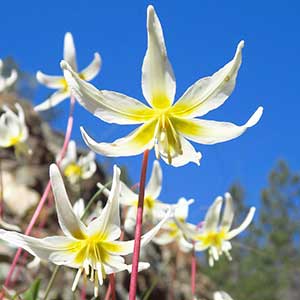Erythronium citrinum
Erythronium multiscapideum
citrus fawn lily, cream fawn lily, lemon color fawn lily, lemon fawn lily, pale fawn-lily
Sierra fawn-lily, Sierra foothills fawn-lily
slender, 40–50 mm, sometimes producing sessile offsets.
ovoid, 20–50 mm, producing bulbels (usually 1–3 per parent bulb) at ends of long, slender stolons.
9–15 cm;
blade mottled with irregular streaks of brown or white, lanceolate to narrowly ovate, margins ± wavy.
4–16 cm;
blade mottled with irregular streaks of brown or white, ± lanceolate, margins entire to wavy.
12–35 cm.
8–23 cm, branching just above leaves near ground level when flowers more than 1.
1–3-flowered.
1–4-flowered.
tepals ± white, often pinkish, usually pale yellow at base, lanceolate to narrowly elliptic, 25–45 mm, inner with or without small auricles at base;
stamens 11–17 mm;
filaments linear, white or pinkish, slender, less than 0.8 mm wide;
anthers white, cream, pink, reddish, or brownish red;
style straight, white or pink, 6–10 mm;
stigma unlobed or with lobes shorter than 1 mm.
flowering individuals generally uncommon in populations, most plants 1-leaved and vegetative;
tepals white to cream with yellow base, broadly lanceolate to elliptic, 16–40 mm, inner with small auricles at base;
stamens 10–15 mm;
filaments white, linear, slender, less than 0.8 mm wide;
anthers white to cream;
style white, 10–13 mm;
stigma unlobed or with recurved lobes 1–4 mm.
obovoid, 2–5 cm.
obovoid, 2–5 cm.
= 24.
= 24.
Erythronium citrinum
Erythronium multiscapideum
Plants lacking auricles on inner tepals are sometimes segregated as Erythronium howellii, Howell’s fawn-lily, but they do not appear to differ from typical E. citrinum in any other characters. Erythronium citrinum intergrades with E. californicum and E. hendersonii, occasional populations or individuals displaying intermediate or recombined characteristics. Such plants from the upper Scott River drainage in Trinity County, California, which may be the result of introgression with E. hendersonii, have been recognized as variety roderickii.
(Discussion copyrighted by Flora of North America; reprinted with permission.)
Erythronium multiscapideum is unusual among western species (and resembles some eastern species) in its tendency to reproduce vegetatively through the production of bulbels at the ends of stolons. It is similar in many respects to E. californicum and sometimes intergrades with it, resulting in occasional populations with the bulb characteristics of one species and the inflorescence branching pattern of the other.
(Discussion copyrighted by Flora of North America; reprinted with permission.)
- Local floras:
CA,
OR
- Local Web sites:
CalFlora,
CalPhotos,
Flora NW,
PNW Herbaria
WildflowerSearch
iNaturalist (observations)
- LBJ Wildflower Center
- SEINet
- Plants of the World Online
- Encyclopedia of Life
- Wikipedia
- Google Image Search


